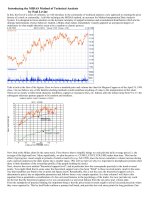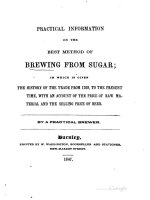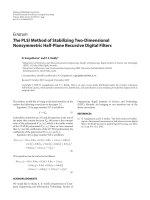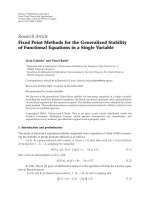Topic 3: The Generalized Method of Moments
Bạn đang xem bản rút gọn của tài liệu. Xem và tải ngay bản đầy đủ của tài liệu tại đây (1.65 MB, 25 trang )
Dr. Pham Thi Bich Ngoc
Hoa Sen University
1
Simple moment conditions
Population
E[ ] 0
Sample
cov[ X , ] 0
1
T
1
T
ˆ
t
X ˆ
0
'
t t
0
2
OLS as a MM estimator
y X , so that ˆ y Xˆ
Moment conditions:
T
E[ ] 0 T1 ( yt X t ˆ ) 0
t 1
E[ X ' ] 0 X ' ( y Xˆ ) 0
MM estimator
1
ˆ
ˆ
X ' y X ' X 0 X ' X X ' y
3
IV is a MM estimator
cov[X , ] 0, but cov[Z , ] 0
Moment condition:
E[ Z ' ] 0 Z ' ( y Xˆ IV ) 0
MM estimator:
Z ' y Z ' Xˆ
IV
0 ˆ
Z ' X Z ' y
1
IV
4
In the previous IV estimator we have considered
the case where the number of instruments is
equal to the number of coefficients we want to
estimate
Size of Z is the same as the size of IV
What happens if the number of instruments is
greater than the number of coefficients?
Essentially, the number of equations is greater
than the number of coefficients you want to
estimate: model is over-identified
5
Maintain the moment condition as before
Variance of moment condition is:
var[Z ' ] E[Z ' ' Z ] 2 Z ' Z W
Minimise ‘weighted’ distance:
V ' ZW Z '
1
1
ˆ
2 ( y ' ' X ' ) Z ( Z ' Z ) Z ' ( y Xˆ )
1
6
First order conditions:
V
X ' Z ( Z ' Z ) 1 Z ' ( y Xˆ ) 0
ˆ
MM estimator (looks like an IV estimator
with more instruments than parameters
to estimate):
1
1
1
ˆ
( X ' Z Z ' Z Z ' X ) X ' Z Z ' Z Z ' y
7
Index: i = 1,...,N for individuals
g = 1,...,G for equations (this would be t=1,...T for a panel)
Data matrices: G rows,
y i1
x i1
y
0
i2
yi
,X
... i ...
y iG
0
K1
0
x i2
...
0
K2
...
...
...
...
...
0
β1
i1
0
β
i2
2
,β =
, εi =
...
...
...
x iG
βG
iG
K G columns
y i X iβ + ε i
8
zi1
0
Zi
...
0
0
zi2
L1
L2
...
0
0
... 0
, G rows (1 for each equation)
... ...
... xiG
... L G columns
...
Such that
zi1,1i1 0
z
0
i1,2 i1
E zi1i1 E
for L1 instrumental variables
...
...
z i1,L1 i1 0
Same for zi2i2 , ...
9
zi1i1 0 L1 rows
z L rows
0 2
i2 i2
E[Ziε] E
, for observation i
... ... ...
ziGiG 0 L G rows
Summing over i gives the orthogonality condition,
zi1i1 0 L1
1 N zi2 i2 0 L 2
1 N
E i=1Ziε E i=1
N
... ...
N
ziGiG 0 L G
rows
rows
...
rows
10
(1) In case of TRIANGLE RELATIONSHIP:
IV is an external variable
STATA:
◦ ivregress gmm depvar1 [varlist1] (depvar2 =
varlistiv)
Estat endog / estat overid
◦ ivreg2 depvar1 [varlist1] (depvar2 = varlistiv),
(gmm2s)
◦ EG:
ivregress gmm Y [X2] (X1 = Z1 Z2 Z3)
Or:
gmm (Y - {b1}*X2 - {b2}*X1 - {b0}),
instruments(X1 Z1 Z2 Z3) wmatrix(robust)
11
(1) In case of TRIANGLE RELATIONSHIP:
IV is an external variable
STATA:
◦ gmm ([eqname1:]<mexp_1>) ([eqname2:]<mexp_2>) ...
[in] [weight] [, options]
[if]
where <mexp_j> is the substitutable expression for the jth
moment equation
◦ EG:
ivregress gmm Y [X2] (X1 = Z1 Z2 Z3)
Or:
gmm (Y - {b1}*X2 - {b2}*X1 - {b0}), instruments(X1 Z1
Z2 Z3) wmatrix(robust)
12
(2) In case IV is the lagged endogenous
variable:
STATA:
◦ ivreg2 depvar1 [varlist1] (depvar2 = varlistiv),
(gmm2s)
varlistiv will included lagged variables
◦ gmm (Y - {b1}*X2 - {b2}*X1 - {b0}),
instruments(X1 Z1 Z2 Z3) wmatrix(robust)
◦ (Z1 Z2 Z3) can be replaced for (L.Z1 L.Z2 L2.Z3)
13
Linear generalized method of moments (GMM)
Arellano-Bond (1991); Arellano-Bover (1995)/ Blundell-Bond(1998)
yit = αyi,t-1 + x’it β + αi + εit
Reasons: True dependence, observed or unobserved heterogeneity, error correlation
yi,t-1 is correlated with αi
OLS – inconsistent (Nickell, 1981)
Remove αi
(yi,t-1 - yi,t-2 ) is correlated with
(εit - εi,t-1 )
FE – inconsistent (Bond, 2002)
But yi,t-2 is uncorrelated with
(εit - εi,t-1 )
GMM – consistent (Hansen, 1982)
Principle: E[Z’Ê] = 0
2SLS
Σ yi,t-2
SYS – GMM
êit* = 0 for each t>=3
DIF – GMM
collapsed
makes an assumption that
first
difference
of
instruments variables are
uncorrelated with the fixed
effects: yi1 Δwi2 …
Main tests are for serial correlation, over-identifying restrictions (Sargan, Hansen)
14
STATA/panel data
◦ xtabond/xtabond2 depvar varlist [if exp] [in
range]
◦ Options:
gmmstyle(varlist [, laglimits(# #) collapse orthogonal
equation({diff | level | both}) passthru {cmdab:sp: d:)}
ivstyle(varlist [, equation({diff | level | both}) passthru
mz])
15
Common Obtions:
◦ noleveleq
specifies that level equation should be excluded
from the estimation, yielding difference rather than
system GMM.
◦ small
requests t statistics instead of z statistics and an F
test instead of a Wald chi-squared test of overall
model fit.
thng ke t dung f test thay
vi m test
16
Common Obtions:
◦ robust
For one-step estimation, robust specifies that the
robust estimator of the covariance matrix of the
parameter estimates be calculated. The resulting
standard error estimates are consistent in the
presence of any pattern of heteroskedasticity
and autocorrelation within panels.
tranh phuong sai thay doi va da cong tuyen
In two-step estimation, the standard covariance
matrix is already robust in theory--but typically
yields standard errors that are downward biased.
twostep robust requests Windmeijer’s finitesample correction for the two-step covariance
matrix.
◦
17
Common Obtions:
twostep
twostep specifies that the two-step estimator is to
be calculated instead of the one-step.
trong ngoac la nhung bien ko b noi sinh
ivstyle()
specifies a set of variables to serve as standard
instruments, with one column in the instrument
matrix per variable. Normally, strictly exogenous
regressors are included in ivstyle options, in order
to enter the instrument matrix, as well as being
listed before the main comma of the command
line.
18
Common Options:
gmmstyle : specifies a set of variables to be used
as bases for "GMM-style" instrument sets.
laglimits(a b): for the transformed equation, lagged
levels dated t-a to t-b are used as instruments,
while for the levels equation, the first-difference
dated t-a+1 is normally used.
+ a and b can each be missing ("."); a defaults to 1
and b to infinity.
+ E.g., gmm(w, lag(2 .)), the standard treatment for
an endogenous variable, is equivalent to gmm(L.w,
lag(1 .)), thus gmm(L.w).
+ the lag limits are a and b, then lags of the
specified variables in differences dated t-b to t-a
are used.
tat ca bien qua khu deu dung lam bien cong cu
19
Arellano-Bond test for AR(1) in first differences.
The null hypothesis: no autocorrelation
If p-value <5% AR(1) in first differences exist
The Sargan-Hansen test is a test of overidentifying
restrictions (REF. Topic 19a)
If p-value >5% instruments are valid
20
The augmented Cobb- Doughlas model:
LnY = F (LnK, LnL, LnM, LnFDI)
INPUT ENDOGENEITY PROBLEM
21
22
23
24
25









